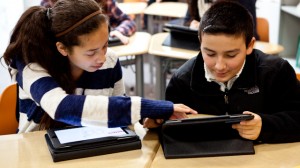On the contrary, video games may be indicative of a shift in the way we construct narrative. A good argument could even be made that video games are the new mythology, a kind of non-linear interactive storytelling that shapes the conscious attitudes of today’s youth. Video games might even represent the modern examples of storytelling that will eventually become the classics of literature in hyper-connected centuries to come. After all, nobody could’ve imagined that the novel would be so important to the future of schooling when they read Miguel de Cervantes’ Don Quixote in 1605.

If video games are shaping the conscious attitudes of an entire generation, we need to start asking difficult questions about the kinds of stories we want to tell. These video games are shaping the next generation. These video games are teaching our students how to think about the world, how to make meaning. And we’re letting it happen by accident. That’s crazy. We need help from Humanities teachers.
How can we be more cognizant of the implicit messaging in video games? In my book, FREEPLAY, I try to model a practice and a method of analyzing the underlying psychology of video game narrative. But we need more people to jump on that bandwagon. We need more video game studies departments that are not about game development and computer programming, but rather about critical thinking. Not video game classes that analyze game design and mechanics -- video game classes that are about analyzing the literature of gaming. We have film studies, now it's time for video game studies.
You can start by adding a game to your curriculum. In my undergraduate college classroom, I sometimes require all of my students to play a popular game in the weeks immediately following a unit on Freud. I challenge them to analyze the game like a dream. I ask them to identify the latent content. We identify gender biases, the subtle differences between games aimed at boys and games aimed at girls. What skills are these games teaching? What conceptions of reality are they privileging?
There are also many games that are intentionally created to provoke thought. Some games are designed so that they force us to ask questions. One good example is a game called Republia Times. In the game, you are editor-in-chief of the newspaper in “the free nation of Republia.” Your job is to use your influence to sway public opinion. How much space on the front page do you give to each article? Which items coming over the wire do you ignore? What and how do you deem things newsworthy? You must make quick decisions as stories come into the newsroom. How do the stories impact the readers’ loyalty to the government? You earn points by increasing readership and manufacturing more citizens that are loyal to the state.
This is a simple game that students can play for a few minutes. It's free and web-based, and works in any browser. You could assign it as homework.
Imagine how this game could fit into a social studies classroom. Imagine the discussion it could inspire about free speech, about how political conversations are framed, about media bias, about political agendas. This is a game that inspires critical thinking rather than rote memorization.
There are many games like The Republia Times, and they belong to a category that’s often called “Social Impact Games.” These are games designed as simulations of real life situations. The mechanics of the game are organized with images and stories in order to make the underlying patterns in our present culture more apparent. They are essentially interactive essays and social commentaries. Or, from a teacher's perspective, they are simply games that can be used as texts.
The great thing about using video games as a text is that they help to make it clear that the reason I’m writing this series about bringing video games into the classroom is not because game-based learning is some amazing new technique or method for teaching. Instead, the reason we teach in the first place, and the reason to bring video games into the classroom is social impact.
We want to educate students into good citizens for a future world that’s better than the one we live in now. We do that by teaching students to think critically about the world. We do that by teaching them to think about the images, stories and technologies that surround them.


